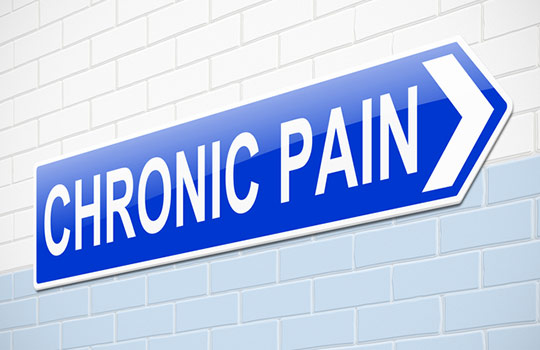 Months of pain makes it chronic. Anything else is considered acute. That’s about the extent of the definition given in the International Statistical Classification of Diseases and Related Health Problems (ICD-10). Trying to pinpoint a definition brings up chronic intractable pain (R52.1), other chronic pain (R52.2), and persistent somatoform pain disorder (F45.4). And this doesn’t include the many other individual syndromes and named entities (some very rare) that are experienced as chronic pain (for example, cluster headache syndrome (G44.0) or diabetic neuropathies).
Months of pain makes it chronic. Anything else is considered acute. That’s about the extent of the definition given in the International Statistical Classification of Diseases and Related Health Problems (ICD-10). Trying to pinpoint a definition brings up chronic intractable pain (R52.1), other chronic pain (R52.2), and persistent somatoform pain disorder (F45.4). And this doesn’t include the many other individual syndromes and named entities (some very rare) that are experienced as chronic pain (for example, cluster headache syndrome (G44.0) or diabetic neuropathies).
To make matters worse for estimating the burden of chronic pain, all these codes can be given in parallel. Measuring the prevalence of chronic pain based on clinical data is therefore impossible: you either see the tip of the iceberg or you risk overestimating it. So, how much chronic pain is there to worry about? How many people are affected by new regulations and sudden changes of public policy? Nobody can be sure. The World Health Organization (WHO) has identified this wide gap in reporting.
A common definition is our best way of understanding the scale of the epidemic of chronic pain. It could also help form a more rational basis for policies around the use of opioids and other narcotics and controlled drugs in medical treatment.
The critical efforts of the International Association for the Study of Pain (IASP) have resulted in a draft proposal for classifying chronic pain in ICD-11. In the draft seven different forms of chronic pain come under one single main heading (a completely new entry).
The proposal by IASP to change the definition of chronic pain in ICD-11 includes another new feature that responds to the question of how people are doing on treatment. Not only will the severity of pain be measured and coded (which in itself is an innovation), but two more optional codes are also proposed to monitor any dysfunction and/or distress resulting from chronic pain. These qualitative codes (patient reported outcomes) could also be a basis for better understanding the manageable threshold of pain that Mao and Kitz refer to as the aim of chronic pain management in their editorial in The BMJ.
Kelly Young, president of the Rheumatoid Patient Foundation, recently described the obstacles that the crackdown on misuse of prescription drugs created for people living with chronic pain. And Penney Cowan, founder of the American Chronic Pain Association (a patients’ organisation), estimates that there are 100 million people living with chronic pain in the US. Penney set out to establish the International Pain Management Network, a global effort to bring patients’ voices to the forefront to achieve better pain management, and she wanted to know how people around the world are living with chronic pain. She created an online survey through the International Pain Management Network, which more than 600 people from 32 countries responded to.
In December 2016, the International Pain Management Network met in Berlin to talk about the findings from this effort. We found people living with chronic pain almost everywhere that we looked. We found complex stories of discrimination and marginalisation confirmed. A patient odyssey of seeking help for 10 years before diagnosis isn’t a rare occurrence. I somehow felt like I was part of a big global family, with my own experience of living with G44.01 put into perspective. We decided that this completely unsatisfactory situation could only be improved by raising awareness about it at the World Health Assembly. So we reached out to IASP and to the International Alliance of Patients’ Organizations (IAPO) to work with us towards that goal.
The International Pain Management Network, IAPO, and IASP are planning to hold a side meeting at the 2017 World Health Assembly. The meeting will explore why patients urgently need better pain management, globally, and what patients have to report about their care. Jolanta Bilińska, chair of IAPO, sees chronic pain as an issue that is common to almost all patients and which should be top of the WHO’s agenda. Speaking with Rolf-Detlef Treede, who is responsible for the ICD-11 review at IASP, he supports a reinforced effort of WHO member states to address pain management and to provide better global monitoring and reporting.
Last week I presented the ICD-11 project to pain specialists from centres and private clinics in Brandenburg (IABSP). The new ICD-11 proposals were broadly welcomed and there was consensus for very substantially changing ICD-10’s definitions. The proposal is undergoing field testing and will be intensively studied in 30 countries. Physicians worldwide are invited to register for the field testing by sending an email to: icd11@iasp-pain.org. And there is an ongoing opportunity to comment on and suggest improvements to the entire WHO beta draft of ICD-11 online.
Matthias Wienold, MD, MPH, has been working with patient organisations since 1986. He is board treasurer for the International Alliance of Patients Organizations (IAPO) and is also a member of The BMJ’s patient panel.
Competing interests: Matthias Wienold contributes to the development of ICD-11 on behalf of his employer, the state wide association of statutory health insurance physicians in Brandenburg (Germany), KVBB. He is a member of the International Pain Management Network steering group. He is a governing board member of IAPO.
See Matthias’s profile on The BMJ’s patient panel page.
